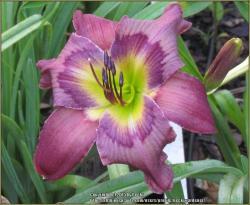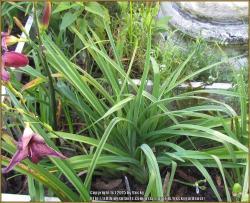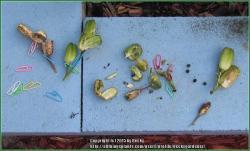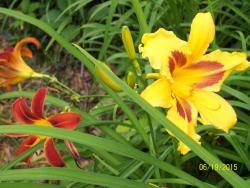Also, begin with a trait that jumps out at you, one you really like. For one example, I like roundish forms, and
notice that the appearance of a roundish form comes from wide short petals. Blunt, wide sepals complete the roundish look.
I have used Happy Happy with its wide blunt sepals and wide petals to cross with various other daylilies to see if the trait was indeed a dominant trait. Most of the time it is. It also is extremely so when crossed with
another plant that has a similar characteristics.
Often, some characteristic will garner your attention even before you realize what it is about it that you
like. Then the detail hits you. Look carefully to see what that or those details are.
Wide borders are another detail that appeals to me. Cross with another one with wide borders, and much of
the time you won't be disappointed. However, sometimes a trait comes from the grandparents or farther back. Check to see what characteristics appear more frequently in the plant's background on both sides.
Then, of course, there are the colors. The easiest course of action is to cross blues with blues, red with reds, purples with purples, and so forth. But, you can achieve various shades when coupling darker shades with lighter shades, or pinks with blues, or purples with reds, etc. Sometimes you may cross two colors and get yellow even when you see no yellow in that cross choice. Look at every color in eye and edge types. What to pair up with the base color, the eye and edge color. Do the same with edges, whether single, double, or triple edges.
Note that some blossoms have flat pleated ruffles, some globs, some tiny outlines of edge. Shapes of
eyes are another feature, or large or small eyes. Eyes that have distinct outlines of color and so forth.
Some color combinations will give you mud, but I've found that to be trial and error, and change course.
There are many parts pieces to the puzzle of the daylily blossoms. Look closely. Pick your favorite
pieces, and explore which fits what.
There are chances of getting what you are aiming for. It just may not appear in every seedling. Nor, do you
have to plant thousands of seedlings to achieve your goals. I have had as little as 10 or so of the same cross produce the desired result. Mostly, I want variety in seedlings, so I make few of the same crosses, but many different ones. This has helped me immensely to see which characteristics are dominate and which are recessive. It's the dominate traits that when paired up with another of similar dominance give me more of what I'm aiming for. It's more or less learn by doing. On the job training, I guess.
There are so many different goals to consider such as patterns, eye and edge, unusual forms, large green eyes, green edges, large blossoms, small ones, various colors, various shapes, something totally different and unusual. Personally, I like most of them although I have read that one should stick to only one or two to be able to achieve a goal. Rather, I prefer to experiment which is so much more fun, at least for me.
Look at flowers for sell. See if they have the traits you want to use.
Just decide what your goals are, what you want to see, and go for it.




